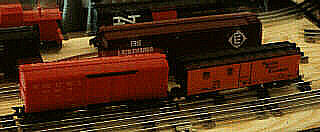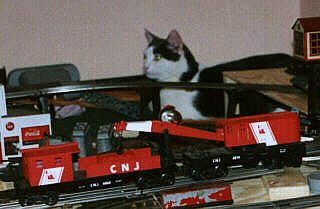Photographs, text and html copyright 2000 T. Sheil & A. Sheil All
Rights Reserved
Common O Gauge Boxcars
How scales affect the action
The differences in scale affect how you run your trains. O27 cars are
significantly smaller than Scale 1/48. You can build a longer O27 train
in much less space. Even compared to the Classic 6464 types, the O27
cars make a difference. They give you the luxury of having longer trains
in less space. Note below how a foursome of classic O27 cars takes
very little more space than a threesome of Classic O cars.
As with passenger cars, length is notthe only issue. We have to account
for height and depth, as well. O27 cars are narrower than Scale or
6464 cars. 6464 cars are conspicuously narrower than Scale cars, as
well, but are wider than O27. O27 is almost comparable in height to a 6464,
but is much lower than the 1/48 car. These things matter when
combining cars in a train, and in selecting motive power.

L to R: Classic O27, 6400, and Marx O27. Both O27 cars are 1/64 over
O |

Marx car's profile is taller than S because of trucks. Bodies are
comparable. |

6464 / 6400 boxcar beside S gauge car. Railking EL boxcar is in back.
It is a 50' car, with a height approaching that of 1/48 cars. |

Two 6400s and Railking 50' compared to line of Classic O27 boxcars. On
a small pike, it makes a big difference. |

In profile, the 1/48 car is slightly taller and longer than a Classic 6464
/ 6400. It is much larger than its O27 counterpart. S gauge
car in front look lower due to its trucks and wheels, but body is comparable
to O27. |

Leif the Cat only goes on the layout when trains are running. |

O27 cars look squat and short with 1/48 Docksider |

The 6400 Classic boxcar looks much better here. |

Note how the Scale car is too tall for 4-4-2, whole O27 is perfect and 6464
look fitting. |

Compare cars with (F to B) Marx 0-4-0, Lionel 4-4-2 and Docksider. |
Click here to return to the All Gauge Model Railroading
Page for the best and most free resources for all scales of model
railroading.









